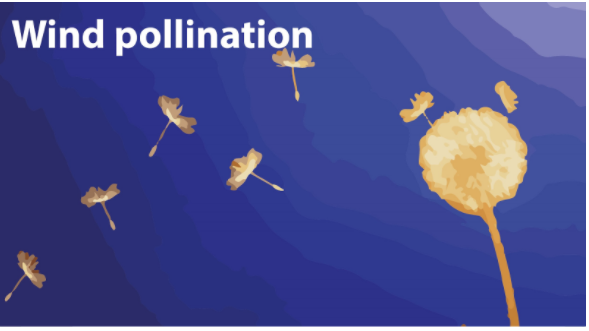
Give four adaptations shown by flowers pollinated by wind.
Answer
572.7k+ views
Hint: The pollen should be such that they can travel easily without any hindrance by the windblown and should not possess features that attract insects but should be in a way that it can be easily blown.
Complete answer:
Wind pollination is also known as anemophily where the pollens are carried and distributed by wind. In these plants, the pollen should be light, small, and non-sticky so that it can be easily blown by the wind.
The four adaptations are shown by flowers pollinated by wind
-The flowers should be colorless and without the presence of any fragrance so that they do not attract any insects towards them.
-Flowers do not produce nectar as it may attract the insects and they will sit on the flowers to suck its nectar and in the meantime, the pollen will stick to their body.
-The stigma of the flower should be feathery or is net-like so that it can easily catch the pollen grains that came through the wind.
-The pollens are produced in a large quantity by plants because the huge amount of pollens get wasted when they are blown by the wind.
Wind pollination is the most common type of abiotic pollination. The flowers of these types of plants do not have colorful petals and the stamens will stand erect and exposed so that they can easily be dispersed by wind currents.

Note: Pollination is the process of transfer of pollen (male part) to the female part (stigma) of the flower leading to fertilization and resulting in the formation of seeds. It may occur by various means – Anemophily (by wind), hydrophily (by water), zoophilia (by animals), myrmecophily (by ants), entomophily (by insects), etc.
Complete answer:
Wind pollination is also known as anemophily where the pollens are carried and distributed by wind. In these plants, the pollen should be light, small, and non-sticky so that it can be easily blown by the wind.
The four adaptations are shown by flowers pollinated by wind
-The flowers should be colorless and without the presence of any fragrance so that they do not attract any insects towards them.
-Flowers do not produce nectar as it may attract the insects and they will sit on the flowers to suck its nectar and in the meantime, the pollen will stick to their body.
-The stigma of the flower should be feathery or is net-like so that it can easily catch the pollen grains that came through the wind.
-The pollens are produced in a large quantity by plants because the huge amount of pollens get wasted when they are blown by the wind.
Wind pollination is the most common type of abiotic pollination. The flowers of these types of plants do not have colorful petals and the stamens will stand erect and exposed so that they can easily be dispersed by wind currents.

Note: Pollination is the process of transfer of pollen (male part) to the female part (stigma) of the flower leading to fertilization and resulting in the formation of seeds. It may occur by various means – Anemophily (by wind), hydrophily (by water), zoophilia (by animals), myrmecophily (by ants), entomophily (by insects), etc.
Recently Updated Pages
Master Class 11 Social Science: Engaging Questions & Answers for Success

Master Class 11 Physics: Engaging Questions & Answers for Success

Master Class 11 Maths: Engaging Questions & Answers for Success

Master Class 11 Economics: Engaging Questions & Answers for Success

Master Class 11 Computer Science: Engaging Questions & Answers for Success

Master Class 11 Chemistry: Engaging Questions & Answers for Success

Trending doubts
What is meant by exothermic and endothermic reactions class 11 chemistry CBSE

Which type of resource is iron ore A Renewable B Biotic class 11 social science CBSE

10 examples of friction in our daily life

Differentiate between an exothermic and an endothermic class 11 chemistry CBSE

Difference Between Prokaryotic Cells and Eukaryotic Cells

1 Quintal is equal to a 110 kg b 10 kg c 100kg d 1000 class 11 physics CBSE




